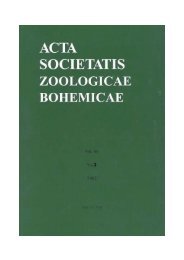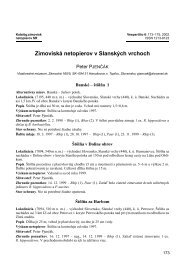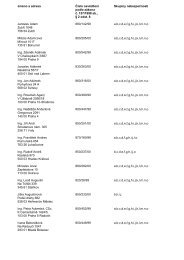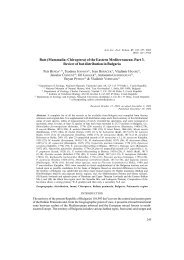You also want an ePaper? Increase the reach of your titles
YUMPU automatically turns print PDFs into web optimized ePapers that Google loves.
Ivo Chlupáč – Vratislav KorduleA10 mmB10 mmCFig. 7. Proboscicaris hospes sp. n. – the holotype VK45a interpretedas the right carapace valve. A – the entire remain; B– enlarged part of the left part; C – schematic drawing. Vinicenear Jince.gular, with carapace horn anterior-produced into spatulatebeak (Rolfe 1969).Remarks. With one exception, only isolated carapacevalves are preserved, reaching in the type species thelength of more than 100 mm and in the other species – P.ingens Rolfe, 1962 – up to 156 mm. The reticulate sculpture,resembling Tuzoia, is less marked and only locallypreserved on the carapace valves of the type species as reportedby Rolfe (1962). The genus has been so far knownexclusively from the Middle Cambrian of North America(Burgess Shale and Utah). Its occurrence in Bohemia isthe first of this kind in the Old World.Proboscicaris hospes sp. n.Text-fig. 7 A–CHolotype: right carapace valve VK45a, b moderatelydeformed by pressure and preserved with its counterpart.Derivation of name: from Lat. hospes = guest(subst.).Type locality: Vinice near Jince.Type stratum: Jince Formation (middle part), intervalbetween the Eccaparadoxides pusillus and Paradoxidesgracilis Zones, Middle Cambrian.Material: The holotype.Description. Carapace valve prolonged, semiellipticalin outline, tapering posteriorly. Dorsal margin in mostpart of its course straight, without spines, anterodorsal partof the valve protruded into broad, anterior-rounded“beak”. Anteroventral margin gently curved, ventral margingently curved with some irregularities: a slight ventralprojection at about the mid-length of the carapace valve,other irregularities could be due to pressure deformation.The valve is markedly posterior-tapered. It reaches themaximum dorsoventral width of 23 mm slightly anteriorof the mid-length of the valve and attains a width of only9–10 mm near the posterior margin. The posterior marginexhibits two rounded projections the posteroventral ofwhich is slightly longer and more markedly curved thanthe posterodorsal one. The arcuate notch between bothprojections is moderately anterior-curved. The convexityof the valve was modified by pressure but according tomode of preservation it was moderate.Remarks.The assignment to Proboscicaris is based onthe presence of the anterodorsal “beak” and general shape ofthe carapace valve without any marked spines. The diagnosticfeatures of our species are the shape of the prolongedvalve, the broad anterior “beak” and two rounded posteriorprojections separated by an arcuate notch. The last feature resemblesPseudoarctolepis Brooks et Caster, 1956, in whichtwo posterior projections are also developed but the notch betweenthem is more marked and the posterodorsal projectionis sharp and spin-formed (comp. Brooks and Caster 1956,Robison and Richards 1981). The most characteristic featureof Pseudoarctolepis – the anteroventral-situated and posteroventral-directedhollow spine – is lacking in P. hospes.Secondary pressure deformations are expressed in theholotype as irregular wrinkles parallel with the ventralmargin and as irregular depressions and elevations on thevalve surface. No patterns of reticulate sculpture are developedand only very faint and small ridges near the posteriormargin (especially on the posteroventral projection)may be regarded as sculptural elements.174








